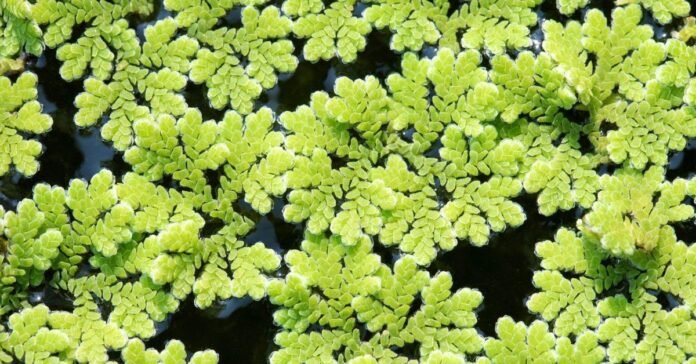
Have you ever noticed a small, delicate aquatic plant forming a vibrant green carpet on the surface of freshwater ponds, ditches, or lakes? Meet Azolla, commonly known as the ‘water fern.’ Once overlooked, this humble plant is now gaining recognition as a game-changer in Indian agriculture. With its incredible ability to fix nitrogen, provide highly nutritious livestock feed, and contribute to sustainable farming practices, Azolla is proving to be a cost-effective and eco-friendly boon for farmers across the country.
Why is Azolla a Game-Changer for Indian Farmers?
Natural Nitrogen Fixation: A Sustainable Fertiliser Alternative
One of Azolla’s most remarkable attributes is its natural nitrogen-fixing capability. In a unique symbiotic relationship with a species of blue-green algae, Anabaena, Azolla absorbs nitrogen directly from the atmosphere. This eliminates the need for expensive chemical fertilizers, which not only burden farmers financially but also harm the environment in the long run. By enriching the soil with essential nutrients, Azolla fosters healthier crops and boosts overall agricultural productivity.
A Superfood for Livestock
Azolla is not just a miracle plant for the soil—it’s also an excellent feed supplement for livestock. Packed with protein, essential amino acids, vitamins, and minerals, it serves as an affordable and highly nutritious alternative to traditional animal feed like soy or maize. Studies have shown that incorporating Azolla into the diet of poultry, fish, and cattle enhances their health, increases growth rates, and improves milk production in dairy cows. As farmers face rising feed costs, Azolla offers a sustainable and low-cost solution that significantly reduces dependency on commercial feeds.
A Natural Mosquito Repellent
Beyond its agricultural benefits, Azolla plays a surprising role in pest control. As it spreads across the water surface, it prevents mosquito breeding by obstructing larvae development, earning it the nickname ‘mosquito fern.’ In regions prone to mosquito-borne diseases, cultivating Azolla can serve as a natural and effective method of reducing mosquito populations.
Water Conservation and Environmental Benefits
Unlike conventional crops that require large tracts of land and significant water resources, Azolla thrives in shallow water, making it ideal for regions with poor soil quality or limited arable land. With its rapid growth rate and high biomass production, farmers can harvest Azolla regularly without depleting natural resources. Additionally, its dense mat-like structure helps prevent excessive water evaporation, conserving precious water supplies in drought-prone areas.
How to Cultivate Azolla: A Simple Guide for Farmers
One of the biggest advantages of Azolla farming is its ease of cultivation. With minimal investment and maintenance, even small-scale farmers can successfully integrate it into their farming systems. Follow these simple steps to start growing Azolla:
1. Ensure Proper Water Quality
Azolla thrives in clean, still water with a neutral pH level between 6 and 7. Avoid using polluted water, as it may hinder growth.
2. Set Up a Suitable Growing Area
Shallow, stagnant water bodies such as ponds, ditches, or even tanks make ideal growing environments. If space is limited, Azolla can be grown in containers with a water depth of 30-40 cm.
3. Maintain Optimal Temperature Conditions
Azolla flourishes in warm temperatures ranging from 25-30°C. Avoid growing it in water temperatures below 20°C, as colder conditions can slow its growth.
4. Planting and Nutrient Boosting
Spread a small quantity of Azolla evenly over the water surface. It multiplies rapidly and will soon cover the entire area. To encourage healthy growth, supplement the water with Super Phosphate and cow dung slurry, providing the necessary phosphorus and nutrients.
5. Regular Maintenance for Maximum Yield
Although Azolla requires minimal care, regular harvesting ensures continuous growth. Prevent overcrowding by skimming excess growth off the surface.
6. Harvesting and Usage
Azolla can be harvested every 5 to 7 days. Simply scoop it from the water, then use it fresh or dry it for later use. After two weeks of initial growth, a 2m x 2m pond can yield approximately 1kg of Azolla daily.
The Future of Azolla in Indian Agriculture
As Indian farmers face challenges like rising input costs, soil degradation, and climate change, the need for sustainable, cost-effective agricultural solutions has never been greater. Azolla presents a viable alternative to conventional fertilizers and livestock feed, reducing expenses while promoting eco-friendly farming practices.
With increased awareness and adoption, Azolla has the potential to revolutionize Indian agriculture, offering economic and environmental benefits to farmers nationwide. From small-scale rural farms to large agricultural enterprises, this tiny aquatic fern is proving that big solutions can sometimes come in the smallest forms.
Embracing Azolla is not just a step toward sustainable farming—it’s a leap toward a greener and more prosperous future for Indian agriculture.

